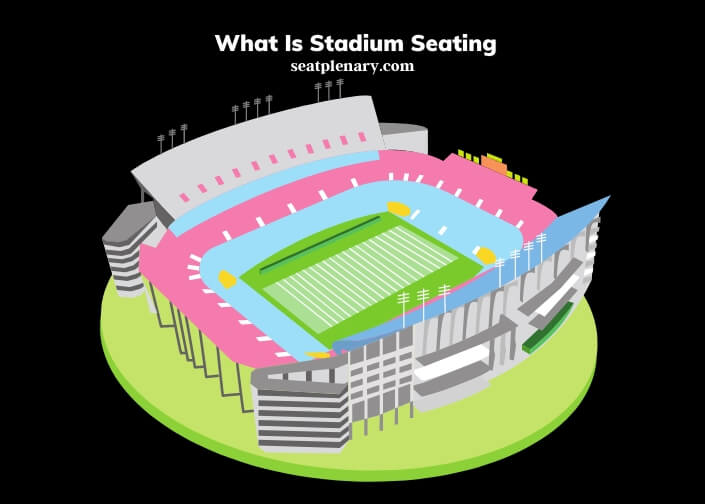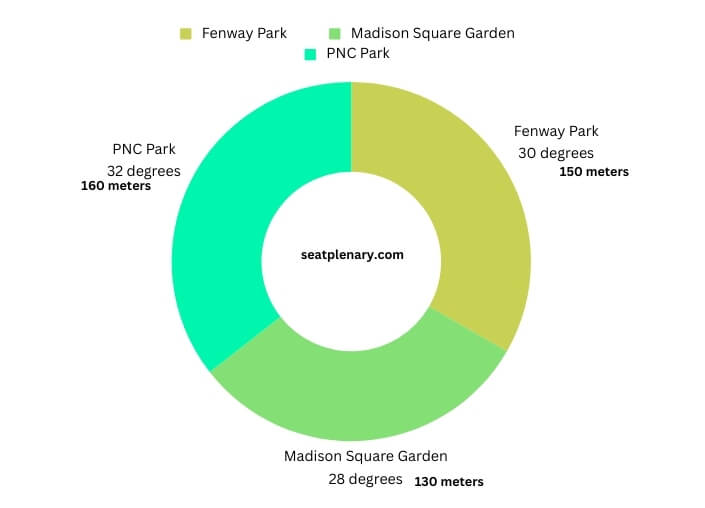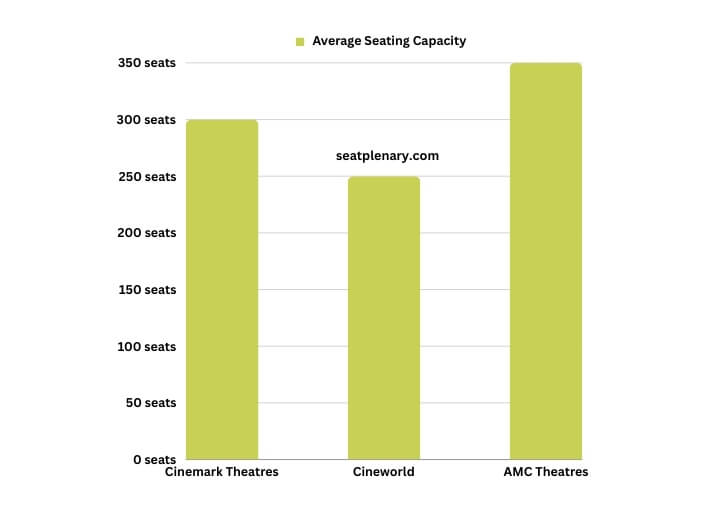Published on: December 11, 2023
Written by Evander Mac / Fact-checked by Jamal Haider
Stadium seating refers to a tiered seating arrangement commonly found in large venues, particularly sports arenas and movie theaters. This design elevates each row of seats above the one in front of it, ensuring an unobstructed view for every spectator.
Stadium seating is a critical aspect of modern venue design, enhancing the viewing experience in various settings, from sports arenas to movie theaters. The concept is simple yet effective: each successive row is positioned higher than the one in front, allowing spectators to enjoy clear, unblocked views. This design is especially prevalent in large stadiums, where accommodating a vast number of spectators without compromising on visibility is essential.
The number of seats in a stadium can vary widely, depending on the venue’s size and purpose. Large sports stadiums, for instance, can accommodate tens of thousands of spectators. The seating arrangement is meticulously planned and detailed in stadium seating charts, which help attendees locate their seats and understand the layout of the venue. These charts are crucial for large events, where efficiently guiding a massive influx of people to their designated seats is a logistical necessity.
Stadium seating design also plays a pivotal role in enhancing the overall experience. Seats are not only arranged for optimal visibility but are also designed for comfort and safety, adhering to specific stadium seating standards. These standards ensure that each seat offers a satisfactory view while maintaining necessary safety measures.

In the realm of entertainment, stadium seating has transformed the movie-going experience. Theaters with stadium seating, such as Regal cinemas, provide moviegoers with a clear, unobstructed view of the screen, replicating a mini-version of the sports stadium experience. This seating style is now a sought-after feature in modern movie theaters, elevating the cinematic experience.
For a more detailed exploration of stadium seating, including its various applications in sports and entertainment, and insights into different seating designs and standards, I invite you to read the comprehensive article below.
What is Stadium Seating?
Early History and Development
Stadium seating isn’t a new concept; it’s been around for centuries. Think back to the ancient amphitheaters of Greece and Rome, where tiered seating was used to give audiences a clear view of the stage. This early design set the foundation for modern stadium seating. It was all about creating a space where everyone could see the action, whether it was a play, a gladiator fight, or a public speech.
Transition to Modern Stadium Design
Fast forward to the present, and you’ll see how much stadium seating has evolved. Today’s stadiums are architectural marvels, combining aesthetics, functionality, and technology. The transition from simple stone steps to cushioned, retractable seats reflects our understanding of audience comfort and the importance of an unobstructed view. This evolution mirrors the changing dynamics of public entertainment and the growing demand for more immersive experiences.
Design Principles of Stadium Seating
Ergonomics and Comfort
When we talk about stadium seating today, comfort is key. Designers focus on ergonomics, ensuring that seats support your back and legs, even during those nail-biting overtime periods or extended concerts. It’s not just about seeing the game or show; it’s about enjoying it without getting a stiff neck or sore back.
Sightlines and Visibility
Visibility is the cornerstone of stadium seating design. The goal is to ensure that every seat in the house offers a clear view. This involves calculating sightlines – imaginary lines from the viewer’s eye to the stage or field. Designers work hard to minimize obstructions, ensuring that even the farthest seat offers a decent view of the action.
Comparison of Sightline Angles in Different Stadiums
| Stadium Name | Average Sightline Angle | Maximum Seating Distance |
| Fenway Park | 30 degrees | 150 meters |
| Madison Square Garden | 28 degrees | 130 meters |
| PNC Park | 32 degrees | 160 meters |

Stadium Seating Standards and Regulations
Safety Measures and Compliance
Safety is a top priority in stadium design. Standards and regulations ensure that seating is not only comfortable but also safe. This includes aspects like structural integrity, fire safety, and emergency egress routes. Compliance with these standards is non-negotiable, as the well-being of thousands of spectators depends on it.
Accessibility and Inclusivity
Inclusivity in stadium seating means ensuring that everyone, regardless of physical ability, can enjoy events. This includes wheelchair-accessible seating, adequate legroom, and easy access to facilities. It’s about creating an environment where all fans can come together to share their passion.
Global Stadium Seating Safety Standards
| Country/Region | Safety Standard Name | Key Safety Features |
| USA | NFPA 101 | Fire safety, egress paths |
| EU | EN 13200-1 | Structural integrity, crowd management |
| Australia | AS 4654.1 | Emergency exits, accessibility |
Stadium Seating in Sports Arenas
Design Variations Across Sports
Different sports require different seating arrangements. In basketball arenas, fans want to be close to the court, while in football stadiums, a panoramic view is preferred. This leads to variations in design, with each sport tailoring the seating layout to enhance the viewing experience.
Impact on Fan Experience
The design of stadium seating directly impacts how fans experience the game. Good seating brings them closer to the action, creating a more intimate and thrilling atmosphere. It’s about feeling the energy of the crowd and being part of the excitement.
Iconic Sports Stadiums and Their Seating Arrangements
| Stadium Name | Sport | Notable Seating Feature |
| Oracle Park | Football | Close-to-field seats |
| Petco Park | Basketball | Elevated courtside seating |
| Busch Stadium | Baseball | Panoramic outfield seats |
Stadium Seating in Theaters and Entertainment Venues
Evolution in Movie Theaters
Stadium seating revolutionized the movie theater experience. Gone are the days of flat floors and blocked views. Modern theaters mimic the tiered design of sports arenas, ensuring everyone has a clear view of the screen. It’s about immersing yourself in the movie without distractions.
The Role of Stadium Seating in Enhancing Viewing Experience
In theaters, stadium seating does more than provide a good view; it enhances the overall experience. It creates a sense of space and privacy, allowing you to get lost in the film. This design also improves acoustics, ensuring that you catch every line of dialogue and every note of the soundtrack.
Seating Capacity and Layout in Major Movie Theaters
| Theater Chain | Average Seating Capacity | Seating Layout Feature |
| Cinemark Theatres | 300 seats | Inclined auditoriums |
| Cineworld | 250 seats | High-back chairs |
| AMC Theatres | 350 seats | VIP seating areas |

Technological Advancements and Future Trends
Innovative Materials and Sustainable Practices
The future of stadium seating is not just about comfort and views; it’s also about sustainability. Designers are experimenting with eco-friendly materials and energy-efficient designs. It’s about reducing the carbon footprint while enhancing the spectator experience.
Future of Stadium Seating in a Digital Era
Technology is reshaping stadium seating. We’re seeing seats with built-in screens, wireless charging, and even virtual reality enhancements. The future is about blending the physical and digital worlds to create a new kind of spectator experience.
The Economic Impact of Stadium Seating
Revenue Generation and Seating Capacity
Stadium seating plays a big role in a venue’s profitability. More seats mean more tickets sold, but it’s a balancing act. The goal is to maximize capacity without compromising on comfort or safety. It’s about finding that sweet spot where every seat is the best seat in the house.
Cost-Benefit Analysis of Stadium Renovations
Upgrading stadium seating can be costly, but it often pays off. Improved seating can lead to higher ticket sales, better fan retention, and increased venue attractiveness for events. It’s an investment in the fan experience and, ultimately, in the venue’s future.
FAQs
What Are the Environmental Impacts of Stadium Seating?
The environmental impact of stadium seating is significant, especially considering the materials used and the waste generated. Traditional stadium seats are often made from plastics and metals, which require a lot of energy and resources to produce.
When stadiums are renovated or demolished, these seats can end up in landfills if not properly recycled.
There’s a growing trend towards using sustainable materials and implementing recycling programs. Some modern stadiums are adopting seats made from recycled materials or designed for easier disassembly and recycling. This shift not only reduces the carbon footprint but also promotes a more sustainable approach to stadium construction and renovation.
How Does Stadium Seating Affect Audience Behavior?
Stadium seating can greatly influence audience behavior. The arrangement and comfort of seats can impact how spectators interact with the event and each other. Comfortable seating with good visibility encourages people to stay engaged and focused on the event. On the other hand, cramped or obstructed-view seating can lead to restlessness and frustration.
The way seats are arranged can affect crowd dynamics. For instance, seating that groups fans together can enhance the sense of community and collective enthusiasm, amplifying the overall energy of the event. Conversely, isolated or poorly arranged seating can dampen the communal experience and reduce interaction among spectators.
What Role Does Technology Play in Modern Stadium Seating?
Technology plays a pivotal role in modern stadium seating, enhancing comfort, convenience, and the overall experience. Seats are increasingly being equipped with advanced features like USB charging ports, Wi-Fi connectivity, and even personal screens. Some stadiums are experimenting with smart seats that can adjust temperature or provide information about the event. Technology also aids in crowd management and safety, with systems designed to monitor seat occupancy and facilitate efficient evacuation in emergencies. These technological advancements not only improve the spectator experience but also open up new possibilities for interactive and immersive event experiences.
Can Stadium Seating Impact a Venue’s Acoustics?
Yes, stadium seating can significantly impact a venue’s acoustics. The shape, size, and material of seats can affect how sound travels and is absorbed within the space. Properly designed seating can enhance sound quality by reducing echo and directing sound towards the audience. This is particularly important in concert halls and theaters, where acoustics play a crucial role in the audience’s experience. In sports stadiums, the design of seating can also contribute to the intensity of crowd noise, amplifying the excitement and energy of the event. Therefore, acoustics is a key consideration in the design and arrangement of stadium seating.
How Does Stadium Seating Influence Event Security?
Stadium seating design is a critical factor in event security. The layout of seats must allow for quick and safe evacuation in case of emergencies. Aisles need to be wide enough to handle large crowds, and exits must be easily accessible from all areas.
The visibility from seats can impact security measures. For instance, higher seats provide a broader view, which can help in identifying any disturbances or emergencies in the crowd. Security personnel also benefit from strategic seating layouts that allow them to monitor the audience effectively and respond quickly to any incidents.
What Is the Future of Stadium Seating Design?
The future of stadium seating design is likely to focus on flexibility, sustainability, and enhanced spectator experience. We can expect to see more modular seating designs that can be easily reconfigured for different types of events. Sustainability will also be a key focus, with increased use of eco-friendly materials and designs that minimize environmental impact.
There will be a greater emphasis on incorporating technology into seating, such as augmented reality experiences or personalized comfort controls. The goal will be to create seating that not only provides comfort and a great view but also enriches the overall event experience in innovative ways.
How Does Stadium Seating Affect Accessibility for People with Disabilities?
Stadium seating plays a crucial role in ensuring accessibility for people with disabilities. Venues must provide seating options that are accessible, comfortable, and offer a good view of the event. This includes wheelchair-accessible seating areas, seats with extra legroom, and easy access to facilities like restrooms and concession stands.
The design of stadiums must consider the ease of navigating to and from these seats. This means having ramps, elevators, and clearly marked accessible routes. Ensuring accessibility in stadium seating is not just about compliance with regulations; it’s about creating an inclusive environment where all spectators can enjoy events comfortably and without barriers.
Stadium seating has come a long way from its ancient roots. Today, it’s a blend of art and science, balancing comfort, safety, and visibility. Whether it’s in a sports arena, a movie theater, or any other large venue, the right seating arrangement can transform the spectator experience. As we look to the future, we can expect even more innovations, making every event an unforgettable experience.
